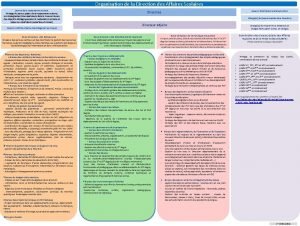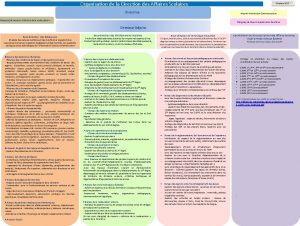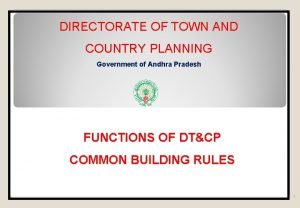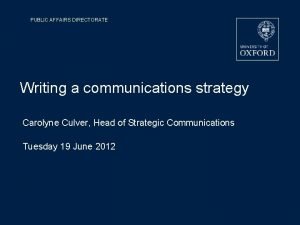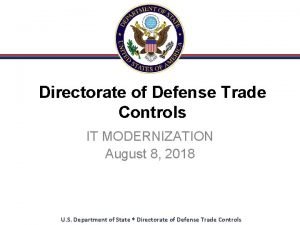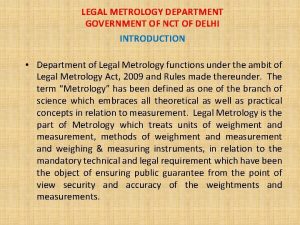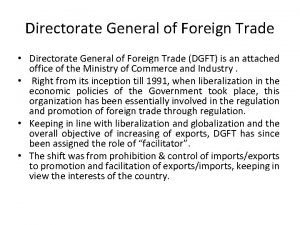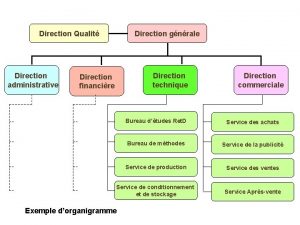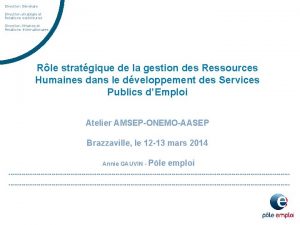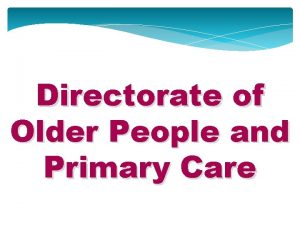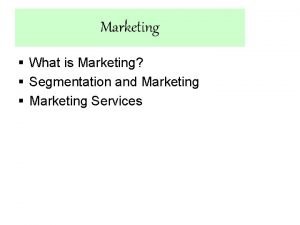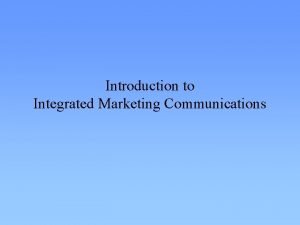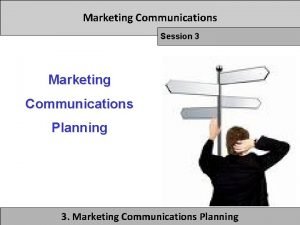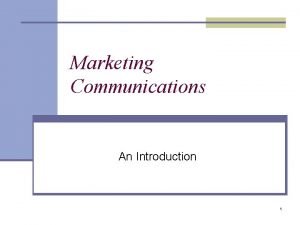Communications Marketing and Consultation Directorate Direction des communications




































- Slides: 36

Communications, Marketing and Consultation Directorate Direction des communications, du marketing et de la consultation (CMCD) (DCMC) Social Marketing …New Weapon in an Old Struggle Jim Mintz Director, Marketing and Corporate Communications Division Health Canada www. hc-sc. gc. ca/socialmarketing

CMCD DCMC Definition of Social Marketing “the application of marketing technologies developed in the commercial sector to the solution of social problems where the bottom line is behaviour change. ” It involves “the analysis, planning, execution and evaluation of programs designed to influence the voluntary behaviour of target audiences to improve their personal welfare and that of society. ” Alan Andreasan

CMCD DCMC Social Marketing …Health Canada • Integrated with overall health promotion strategies e. g tobacco, diabetes, healthy pregnancy • Social marketing team integrated with program and communication functions • Functions include: marketing research, strategic planning, partnerships and strategic alliances and delivering all elements of campaign in conjunction with agencies

CMCD DCMC Health Canada Campaigns • Substance abuse: tobacco, alcohol and drugs impaired driving • Healthy living: physical activity, nutrition, diabetes prevention and CVD prevention • Healthy pregnancy: FAS, folic acid, tobacco etc. • Children issues: injury prevention, parenting immunization, SIDS • Communicable diseases: hepatitis C, SARS, AIDS/STD’s, West Nile virus • Others: healthy environment, organ and tissue donation, seniors issues, aboriginal campaigns

CMCD DCMC Integration with other Components • Social marketing campaigns integrated with other components of health promotion strategy, including: training, education, community mobilization legislation research

CMCD DCMC Purpose of Social Marketing • Social marketing used to: Establish themes and provide focus/profile for health promotion strategy Reach many people at same time Inform public that government is concerned about a specific issue Main task is to influence behaviour change (long term)

CMCD DCMC Uniqueness of Social Marketing • Is different from public education and other communication /health education strategies in that its ultimate goal is to influence and change behaviour, not just to increase knowledge and/or change attitudes • May seek to change values and attitudes as a means of influencing behaviours

CMCD DCMC Challenges of Social Marketing • More difficult to change behaviours that are: high involvement (e. g. donating blood, stop smoking, ) vs. lower involvement. continuing (stopping smoking, flossing) vs. one-time only decisions (donating blood).

CMCD DCMC Challenges of Social Marketing • Low situational involvement for most people many people not interested in social and health causes • Level of Perceived Consumer Efficacy often low even when people aware of a social or health problem they feel helpless and ineffective to help solve it.

CMCD DCMC Challenges of Social Marketing • Attitude change is difficult the less palatable the behaviour change, the more difficult to change. • Lack of immediate reinforcement. Often solution to problems depends on collective action of many people reduces sense of self-efficacy.

CMCD DCMC Influencing Behaviour • Recognizes the need for consumer orientation and analyzing behaviour from the point of view of target audiences. recognizes markets are comprised of market segments requiring different marketing strategies to generate behaviour change. analyzing social behaviours and segmenting markets requires innovative marketing research.

CMCD DCMC Segmentation • Two key ways to segment: Demographic – age, gender, occupation, income, marital status etc. Psychographic – lifestyle, social class, values, personality “It’s more important to reach the people that count, than to count the people you reach”

CMCD DCMC Marketing mix • Coordinated set of interventions including: supporting products and services, (tobacco cessation products, condoms) using marketing communication techniques like advertising, direct marketing etc. distribution ( channel marketing) and pricing strategies developing network of strategic alliances to leverage resources.

CMCD DCMC Rationale Underlying Social Marketing Campaigns • Contribution to the reduction of social costs generated by undesirable social behaviours. • Costs are borne by society which justifies the investment of government resources to reduce them.

CMCD DCMC The Strategic Marketing Planning Process (SMPP) • The Situational Analysis (Internal and External) involves gathering and analysis of information on the organization’s market and other audiences (e. g. sponsors, partners, the public), on the organization itself, competitors or competitive campaigns, and other elements that may likely influence the outcome of the campaign. includes evaluation of the impact of previous marketing efforts.

CMCD DCMC SMPP • Five stages of change: Precontemplation: no intention to change behaviour in the foreseeable future. Contemplation: people aware that problem exists and thinking about changing but have not made commitment to take action. Preparation: combines intention and behavioural criteria. Individuals intending to take action in next month. Action: individuals modify behaviour, experiences, or environment to overcome problems. Maintenance: people work to prevent relapse and consolidate the gains attained during action.

CMCD DCMC Best Practices…Our Experience • Focus on audience segment, message and on most appropriate media vehicle. • Specify the desired outcome. • Focus on personal relevance of issue to each member of audience. • Specify the desired action required (call to action) • Positive reinforcement seems to be effective.

CMCD DCMC Best Practices…Our Experience • Adapt creative style to specific audience. • Message is crucial and need to pretest • Messages should portray people with which members of target group can identify. • Play on emotions. • Celebrities and popular spokespersons can be effective to change social norms.

CMCD DCMC Best Practices…Our Experience • Communicate benefits focus attention on immediate, high-probability consequences of positive behaviour. • Do not be moralistic guilt messages work less well, however can be effective in certain circumstances • Pity appeals and altruistic appeals do not work well • Humour can be difficult – use with caution.

CMCD DCMC Best Practices…Our Experience (Youth) • Do not highlight that communication came from an authority. • Use self-confident, attractive actors that look a few years older than the target. • The web and e-mail are important tools. • Do not show high risk youth in negative light. • Do not present adult viewpoint, or lecture • Do not talk over youth heads or talk down to them.

CMCD DCMC Best Practices…Our Experience • Focus on well-defined market and promote alternative behaviours as substitutes for undesirable present behaviours. • Examples: designated driver in drinking and driving campaigns, or suggesting daily actions as ways to be physically active (use stairs, not elevator) sell benefits of mass transit rather than car. • Showing the desirable behaviour serves as a guide to appropriate behaviour.

CMCD DCMC Multi-Year Consistency in Theme…Hallmark of Success • Consistency required to move target audiences through the various “stages of change”. • Variety in creative approach from one period to the other and one group to the other is required to keep the attention grabbing power of the campaign (however message has to be consistent)

CMCD DCMC Meaningful Impact Takes Time • Only long-term cumulative efforts can produce significant measurable changes. standard time frame is 3 to 5 years. period for achieving results depends on various factors. (sufficient investment, measurable goals, differentiation from other campaigns, creative approach, continuity in message) most campaigns adopt phased approach, each phase building on the results of the preceding one. A solid base for annual plans.

CMCD DCMC Measuring Performance • Intermediate goals are used to measure impact: awareness of campaign, attitude and preference changes, intermediate changes in behaviour, and/or behavioural intent. increases in 2 -4% are common objectives for health promotion related campaigns.

CMCD DCMC Key Challenges • Confusion about what is marketing i. e. advertising/promotion/cost recovery • Concern that Government…big brother is in the behaviour change business • Difference between social marketing and: Health education Public education Strategic Communications Community Outreach

CMCD DCMC Key Challenges (cont. ) • Issue overload • Reaching the “hard to reach” e. g. aboriginal peoples, isolated communities, low income • Many social marketing initiatives are not designed or lead by marketers and tend to be strategic communication/public relations initiatives

CMCD DCMC Key Challenges (cont. ) • Political environment and public scrutiny • Marketing in public sector much different than private sector (Madill article) • Uncontrollable factors (tax cuts on alcohol and tobacco, new legislation) • Attribution is “tough nut” for social marketers… strategic evaluation

CMCD DCMC What Have We Learned • Strategic alliances are extremely important, but you must have guidelines and policies • With rare exception only long term multi year campaigns can produce measurable changes…but management/funders want immediate results

CMCD DCMC What Have We Learned (cont. ) • Too much emphasis on behaviour change (individual rather than the community). Much more emphasis in creating a social climate/consensus conducive to social change…(e. g. tobacco in the 80’s) • “Blame the victim” approach…hurts credibility of social marketing (Low SES and Active Living) • Upstream approaches and strategies helps credibility of social marketing (Heather Crowe)

CMCD DCMC What Have We Learned (cont. ) • Call to action is crucial for social marketing campaign • Need to be much more strategic on selection of promotional mix…new media, TV programming (Degrassi), non-media approaches • The messenger in many cases can be much more important than the message.

CMCD DCMC What Have We Learned (cont. ) • Too much emphasis on promotion and not on other 3 P’s e. g. channels. • “End runs” and “challenge the bureaucracy” if you are going to get anything done (e. g. jurisdictional issues…schools) • Segmentation/targeting fundamental to marketing, but need to be balanced against government mandates.

CMCD DCMC Requirements For Success • Management must understand accept client oriented social marketing approach. • Extensive training in marketing for key staff, as well as use of consultants. • Information systems are needed to: provide information on target audiences. track program costs and performance. track competitors strategies and tactics.

CMCD DCMC Requirements For Success • Ensure that programs are truly social marketing (not public education) - i. e. their long-run objectives are focused on behaviour change. ( note: public education is an integral part of social marketing)

CMCD DCMC Final Thought • Be the first, be the best, take risks, think big and think outside the box • Francois Lagarde: “The Mouse Under the Microscope”…Keys to Particip. Action’s Success (Canadian Journal of Public Health, May/June 2004)

CMCD DCMC Resources • New tutorial being developed ( Health Canada) to be launched on August 9 th. • www. hc-sc. gc. ca/social marketing • Donovan and Kotler books • Carleton, Sprott School of Business Professional Certificate in Public Sector and Non-profit Marketing • http: //www. carleton. ca/ppd/indepth/cpsm. htm

CMCD Jim Mintz Director, Marketing & Corporate Communications Division Health Canada – Santé Canada Telephone/Téléphone: (613) 954 -8839 Fax: (613) 957 -1395 E-mail/CE: Jim_Mintz@hc-sc. gc. ca Web: www. hc-sc. gc. ca/socialmarketing DCMC
 Des des des
Des des des Early childhood directorate
Early childhood directorate Dhs science and technology directorate org chart
Dhs science and technology directorate org chart Norwegian directorate for education and training
Norwegian directorate for education and training General directorate of animal health and production
General directorate of animal health and production Osha directorate of training and education
Osha directorate of training and education Vetanika
Vetanika Osha directorate of training and education
Osha directorate of training and education Osha directorate of training and education
Osha directorate of training and education Air force research laboratory logo
Air force research laboratory logo Organigramme caspe 18
Organigramme caspe 18 Direction des affaires scolaires
Direction des affaires scolaires Contribution directe
Contribution directe Direction des entreprises publiques et de la privatisation
Direction des entreprises publiques et de la privatisation Executive services directorate
Executive services directorate Veterinary medicines directorate
Veterinary medicines directorate Vehicle technology directorate
Vehicle technology directorate Norwegian registration authority for health personnel
Norwegian registration authority for health personnel Credilab
Credilab Dpw fort bragg nc
Dpw fort bragg nc Dtcp ap
Dtcp ap European directorate for the quality of medicines
European directorate for the quality of medicines Technology applications ec-12
Technology applications ec-12 Directorate of logistics
Directorate of logistics Deccs registration renewal
Deccs registration renewal Directorate general for competition
Directorate general for competition Marketed health products directorate
Marketed health products directorate Office of the controller legal metrology
Office of the controller legal metrology Directorate curriculum fet
Directorate curriculum fet Plant protection directorate nepal
Plant protection directorate nepal Tea directorate
Tea directorate Afa tea directorate
Afa tea directorate Directorate general of foreign trade
Directorate general of foreign trade General directorate of public finance
General directorate of public finance Directorate of oilseeds development
Directorate of oilseeds development Directorate of health services kashmir
Directorate of health services kashmir Directorate-general for internal policies
Directorate-general for internal policies










